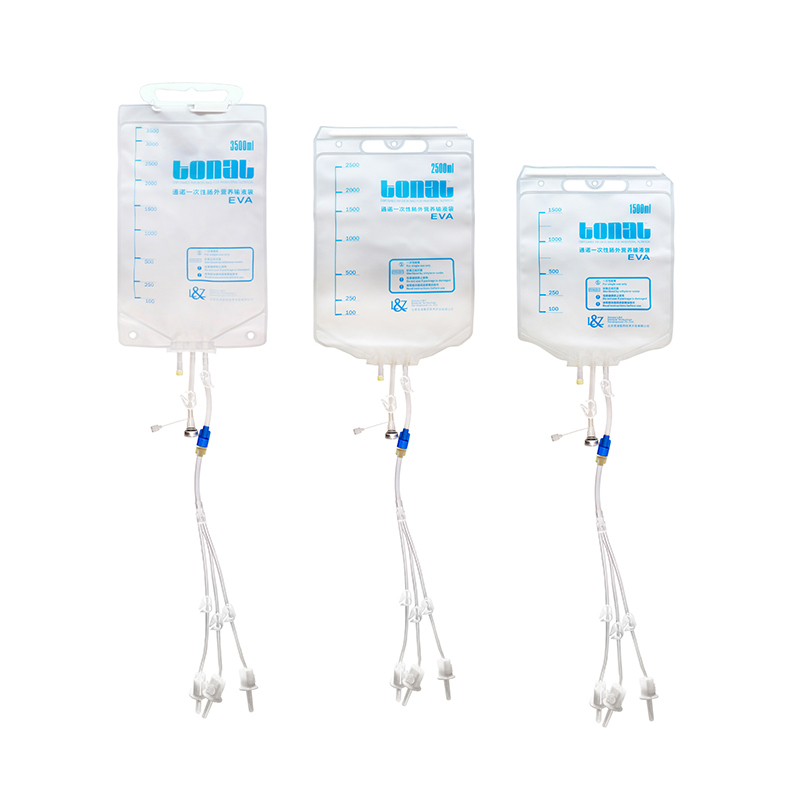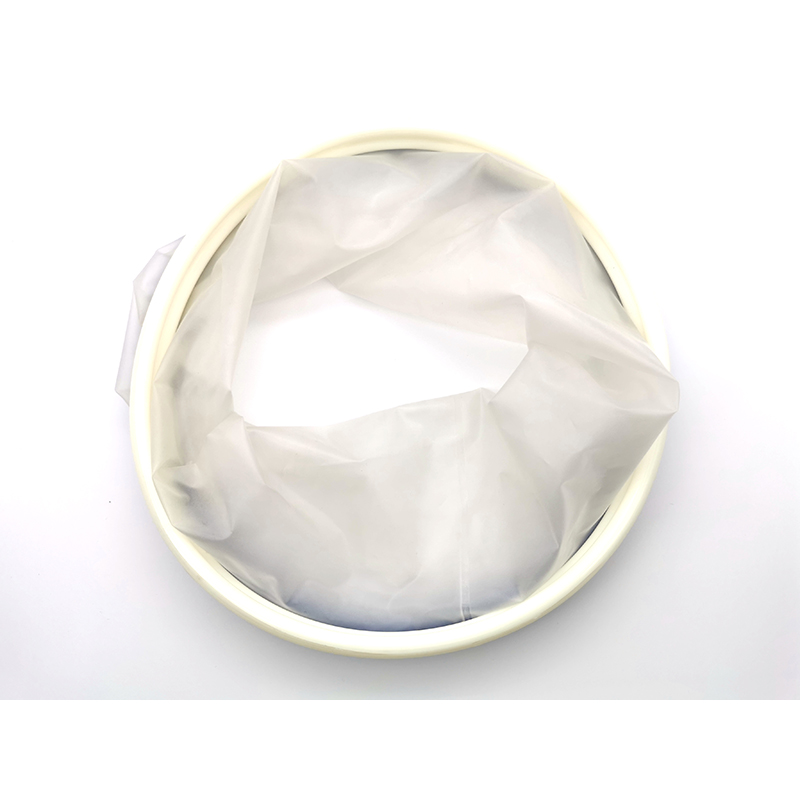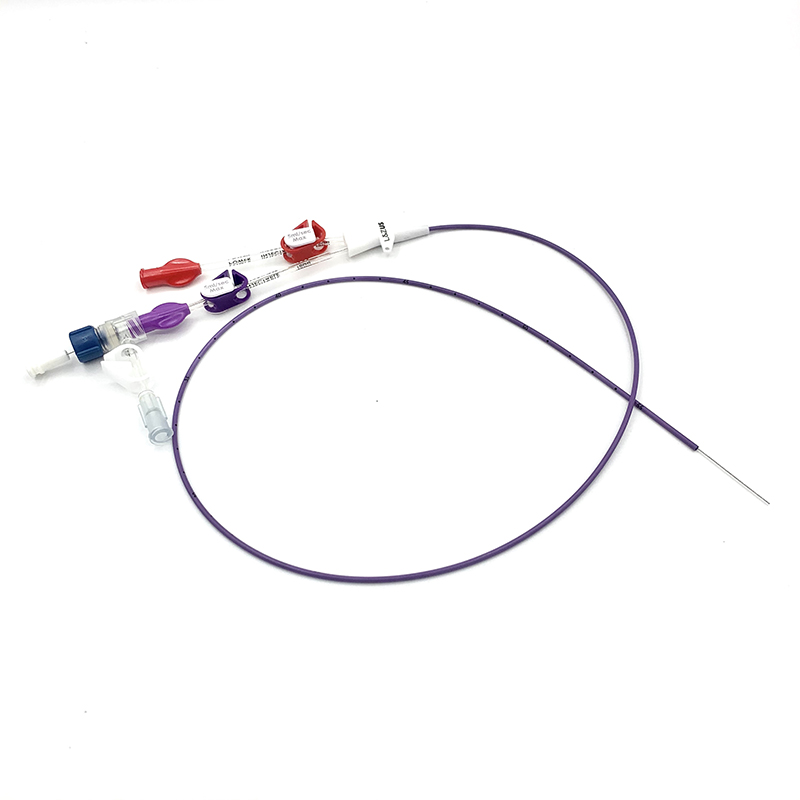
Wholesale China Enteral Feeding Pump Companies Factory - Enteral feeding sets – LINGZE
Wholesale China Enteral Feeding Pump Companies Factory - Enteral feeding sets – LINGZE Detail:
Product Detail
| Commodity |
Enteral feeding Sets |
|||
| Type |
Bag gravity |
Bag pump |
Spike gravity |
Spike pump |
| Code |
BECGA1 |
BECPA1 |
BECGB1 |
BECPB1 |
| Capacity |
300ml/600m/1200ml |
- |
||
| Material |
Medical grade PVC, DEHP-Free, Latex-Free |
|||
| Package |
Sterile single pack |
|||
| Note |
Rigid neck for easy filling and handling, Different configuration for choice |
|||
√ Our disposable enteral feeding sets have four types for different nutritional preparations: bag pump set, bag gravity set, spike pump set and spike gravity set.
√ If nutritional preparations are bagged or canned powder, bag sets will be chosen. If bottled/bagged standard liquid nutritional preparations, spike sets will be chosen.
√ Pump sets can be used in many different brands of Enteral feeding pump.
Cause analysis and treatment of blockage of enteral feeding tube
Enteral nutrition is one of the methods to provide the human body with the required nutrients through the gastrointestinal tract. The main methods include tube feeding and oral administration. Tube feeding usually includes nasogastric/intestinal tube, percutaneous endoscopic gastrostomy, jejunostomy tube and Percutaneous endoscopic jejunostomy, etc. Enteral nutrition is consistent with the physiological state of the patient, the integrity of the intestine is maintained, which can effectively prevent intestinal bacterial translocation and reduce the chance of infection. This operation method is convenient for monitoring, safe and economical, and is obtained in clinical practice. Widely used, but in the process of tube feeding, affected by a variety of factors, it is prone to tube blockage problems, and then the emergence of unplanned extubation events.
According to specialist, the reasons for the clogging of the nutrition tube in the common colon are as follows :
1. Tube related factors
Failure to properly fix the catheter after turning over, causing the exposed part to distort and fold; frequent coughing, nausea and vomiting cause the feeding tube to buckle in the mouth, throat, or in the intestines, which are common mechanical factors for feeding tube blockage. In the study, it was found that the blockage rate of the naso-intestinal tube was higher than that of the nasogastric tube, which was considered to be related to the narrower diameter of the naso-intestinal tube and the longer indwelling length in the body. After the feeding tube is left for a long time, the inner wall of the tube becomes rough due to the erosion of the medicine and the nutrient solution and the corrosion of the digestive juice, which makes the nutrient solution easy to hang on the wall. In addition, the infusion is suspended for too long, the infusion speed is too slow, and the gastrointestinal tract emits blood after the operation, which causes the blood clot to block the pipeline.
2. Nutrient solution factor
The concentration of the nutrient solution is too high, the pumping speed is too slow, the nutrient solution contains cellulose and other factors make the nutrient solution easy to adhere to the inner wall of the lumen, which narrows the lumen and increases the chance of lumen blockage. Studies have shown that the rate of nutrient solution infusion has little effect on the incidence of tube clogging, but it has been clinically found that when the heater is used to warm the nutrient solution, if the speed is too slow, the nutrient solution will be overheated and denatured to form a clot. Block the pipe. In addition, during the intermittent period of enteral nutrition, the nutrient solution in the gastrointestinal tract may block the nutrition tube due to reflux due to severe coughing, sneezing, vomiting and other reasons.
3. Nurse factor
The main reason for the clogging of the nutrition tube is that the nurse does not perform flushing strictly according to the specifications, or the flushing method is wrong. During the operation, the nursing staff did not have a special knowledge of enteral nutrition. During the flushing process, they could not perform various operations in accordance with the regulations, and the flushing time could not be reasonably controlled. The acidity and alkalinity of the injection were different. When the drugs are not treated differently, the pipeline will be blocked. If the nursing staff cannot properly perform various operations in accordance with the doctor’s instructions, random addition of drugs for tube feeding or not paying attention to the enteral nutrition of tube feeding, random stopping during the process of injecting the nutrient solution can also increase the probability of tube blockage. .
4. Patient factors
The patient lacks relevant nursing knowledge, and is unable to carry out the self-management and nursing of the feeding tube in a timely and effective manner. For example, patients suspend the pumping of nutrient solution by themselves due to various reasons.
In response to the above reasons for the clogging of the nutrition tube, we can take the following preventive measures:
Choose the right nutrient solution according to the patient’s condition
In the process of injecting nutrient solution, try to choose a product with a lower concentration. If you want to inject a nutrient solution with a high concentration, you should dilute it before injecting. Before the drug is used, the drug should be shaken. During the use, if the nutrient substance is precipitated, it should also be shaken. In the process of drug injection, it cannot be mixed with other drugs to prevent chemical reactions from occurring, resulting in a decrease in the stability of the substance and the precipitation of nutrients [4].
Reasonable choice of enteral nutrition feeding tube
If the patient is unable to take food by mouth, the patient’s condition should be analyzed, the gastrointestinal structure of the patient should be analyzed, and the appropriate thickness of the pipeline should be selected to prevent the occurrence of pipeline blockage. The name, length, etc. of the patient’s feeding tube should be recorded, and the tube should be replaced in time to prevent the tube from being used after serious bending and deformation [4].
Try to use enteral feeding pumps and matching pump sets
Try to use enteral nutrition pump, speed control is accurate, automatic alarm in case of pipeline blockage, convenient, fast, timely and efficient. The use of a movable infusion stand will effectively reduce the workload of nursing and avoid a series of tube blockage risks such as delayed flushing and twisting of the tube caused by the suspension of enteral nutrition due to the patient’s getting out of bed. The method is as follows: fix the nutrition pump on the movable infusion stand, use AC power when the patient is lying in bed, and ensure that the battery power is working normally when getting out of bed [1].
Strengthen the health education of nursing staff
Strengthen the sense of responsibility of nursing staff, pay attention to professional training of young nurses, and continuously improve professional quality and professional operation skills. Let the nursing staff have the awareness of anti-blocking pipes and take the initiative to make regular inspections to avoid the economic burden and adverse consequences of patients caused by delayed treatment [1]. In order to effectively prevent the clogging of the feeding tube, before the nutrient solution is injected, different nutrient solutions should be analyzed, and appropriate pipeline maintenance techniques should be adopted to ensure that the pipeline is used in a softened condition. Pulse injection can also be used to generate a small vortex during the flushing process in the lumen, which can flush out the substances attached to the tube wall in time.
Strengthen the health education of patients
Nursing staff should strengthen health education on enteral nutrition, formulate special health prescriptions, and let patients and their families understand relevant knowledge and actively participate. For patients with a lack of health knowledge, sufficient attention should be paid to their mental and psychological factors. Before implementing enteral nutrition, the significance, importance and implementation methods of enteral nutrition should be explained in detail. During the implementation process, we often communicate with patients to understand their psychological and physical reactions and provide psychological support. According to the cultural level and learning ability of patients and their families, appropriate methods are selected to fully improve the enthusiasm of patients and their families in learning, which is conducive to improving the quality of clinical enteral nutrition care.
Drug Nasal Feeding
When injecting the drug, it should be fully ground and crushed to form a powder, and after it has been fully dissolved (filtered with gauze if necessary), it is directly injected. Rinse the lumen with 20ml warm water before and after injection to prevent the drug and nutrient solution from clogging in the lumen and causing blockage. The order of administration is: stop nutrient solution drip → flush → dosing (liquid form) → flush again → restart nutrient solution drip. It is not recommended to supply drugs from the naso-intestinal tube. Some drugs (such as Losec, which is clinically proven to be very easy to block the tube) are recommended to be supplied through the gastric tube.
Residual nasal feeding fluid residue found on the exposed end of the enteral feeding tube is a danger signal for blocking the tube.
Judgment criteria for clogged tube: The gastrointestinal nutrition tube is not unblocked, food is not easy to inject, and no liquid is drawn back during the feeding process. If you use a syringe to gently reverse the test and there is still resistance, or if you inject 20ml of warm water and the flow rate is still not smooth, the tube is blocked [3].
For the catheter blockage that has occurred, our nursing staff should actively identify the cause, understand the blockage mechanism, and choose the appropriate treatment. Commonly used clinical dredging methods can be divided into physical methods and chemical methods according to their principles [4].
Physical methods include kneading plus negative pressure suction method and guide wire dredging method.
(1) Rubbing plus negative pressure suction method: When it is found that the nutrient solution is blocked in the nutrient tube, rub the part outside the nutrient tube, and at the same time use a 20ml syringe to pump 10ml of warm water back. Under the action of external force, the clot adhering to the nutrition tube falls off and is sucked out of the nutrition tube under the action of negative pressure. At the same time, the syringe is used to inject warm water into the nutrition tube to flush the pipeline, repeated several times until it is unobstructed. This method is used more clinically, because the nasogastric tube is inserted shallower and the exposed part is long, so it is more suitable. However, the naso-intestinal tube is inserted deep into the body and the exposed part is short, making it difficult to perform the rubbing method.
(2) Guide wire dredging method: Insert a guide wire into the lumen of the nutrition tube, and use mechanical force to dredge the blocked nutrition tube. It should be noted that for patients with a long catheterization time, excessive force may penetrate the nutrition tube, causing nutrient solution leakage and even damage to the digestive tract.
The chemical method uses drugs to dissolve the blockage. Commonly used drugs include digestive enzymes and sodium bicarbonate solution.
(1) Dissolve the digestive enzymes in warm water and inject the clogged nutrient tube under pressure with a syringe with a small diameter of 10ml or less. Digestive enzymes mainly use the digestive action of enzymes to digest the blocked food in the nutrient tube into small molecules to unblock the nutrient tube. 5% sodium bicarbonate solution is alkaline solution, and the main components of enteral nutrient solution are maltodextrin, casein, vegetable oil, minerals, lecithin, vitamins and trace elements, showing weak acidity, 5% sodium bicarbonate The solution can neutralize some of the acidic substances and dissolve ingredients such as lecithin. There are reports in the literature that the precipitation caused by drugs can be adjusted with antagonists (sodium bicarbonate, hydrochloric acid) to restore the precipitate to a dissolved state. The study found that the completely blocked nutrient tube is dredged with 5% sodium bicarbonate solution. 10 minutes can loosen the nutrient solution clot in the nutrient tube with a length of 2-3 cm, and 20 minutes can loosen the nutrient liquid clot in the nutrient tube with a length of 4-5 cm. However, there is almost no release effect when exposed to warm water at 50°C for 20 minutes. The limitation of this method is that most of the clogging of the nutrition tube in clinical practice occurs at the distal end, so it is difficult to reach the injected liquid medicine.
(2) Since sodium bicarbonate solution has a certain dissolving effect on nutrient solution clot and drug crystallization, our department chooses sodium bicarbonate solution as the medicine to clear the clogged nutrient tube. For partially blocked nutrition tubes, sodium bicarbonate solution is used directly to make them unobstructed, and completely blocked nutrition tubes use intravenous extension tubes. Intravenous extension tubes are often used clinically to inject drugs into intravenous pumps. The material is soft and has a certain degree of toughness. It is convenient to insert into the nutrition tube without the risk of damaging the nutrition tube. After cutting off the liquid medicine filter, the length is 128cm and the outer diameter is 2.1mm. It can be used in the models and specifications of Baitong nutrition tubes commonly used in undergraduates. After the venous extension tube reaches the blocked site, inject warm water from the extension tube to flush the lumen from the inside to the outside, which can prevent the clot from falling off the wall when flushing from the outside to the inside and increase the risk of nutrient tube blockage. Moreover, since the drug can directly act on the blocked part, the time required to dissolve the blockage is shortened. Clinical use proves that the combined effect of intravenous extension tube and sodium bicarbonate solution greatly shortens the time required to dissolve the blockage, and has high safety and obvious effect. In clinical use, attention should be paid to: because the sodium bicarbonate solution is alkaline, the amount injected into the digestive tract should not be too much. Once the nutrition tube is restored, it can be rinsed with warm water repeatedly to completely flush the remaining tube wall. purpose. When the amount of flushing is large, pay attention to the acid-base balance of the patient, and at the same time pay attention to whether the patient has abdominal distension and abdominal discomfort.
Enteral nutrition can not only provide the required nutrition for patients and critically ill patients after surgical gastrointestinal tract surgery, but also activate the enteric nerve-endocrine system, promote intestinal peristalsis and mucosal growth, maintain the local immune system and cell function of the intestinal wall, thereby maintaining The body’s immune function. Enteral nutrition is an important treatment method. Preventing and intervening the blockage of the nutrition tube is the top priority of our nursing work. In clinical nursing work, we must pay attention to the causes of nutrient tube blockage, and conduct targeted interventions, so as to effectively reduce the incidence of patient complications, improve malnutrition, and improve clinical efficacy.
About material – our material without DEHP
1.The plasticizer DEHP is not connected to the PVC molecular structure by chemical bonding, and it is easy to precipitate from the material into the liquid when it comes in contact with water or fat-soluble liquid.
2.DEHP has potential hazards such as carcinogenicity and reproductive toxicity. Many countries in the world have banned the use of DEHP in medical products.
3.The disposable Enteral feeding set uses a new plasticizer, which has minimal precipitation and will not accumulate in the body. It meets the medical grade product standards and is suitable for enteral nutrition patients.
Product color distinction
The color of the disposable Enteral feeding set is purple/blue. The purple/blue tube is obviously different from the intravenous infusion tube to prevent the medical hidden dangers of misuse of enteral preparations into the vein.
Detailed design of excellence
Pay attention to all aspects of clinical use
Air guide needle interface, strong compatibility, quick connection with various standard liquid preparations, no need to use air guide needle, air guide hole attached with air filter to effectively prevent air pollution 3-2. The length of the upper tube is divided into two types: 95 cm and 75cm, which are suitable for sky rail type and floor type infusion stand respectively 3-3. The lower tube is equipped with an international standard three-way (Y-type) connector, which is conducive to dosing or flushing the tube 3-4. The standard size trapezoidal feeding tube connector is detachable, suitable for connecting various feeding tubes of different diameters.
Product detail pictures:
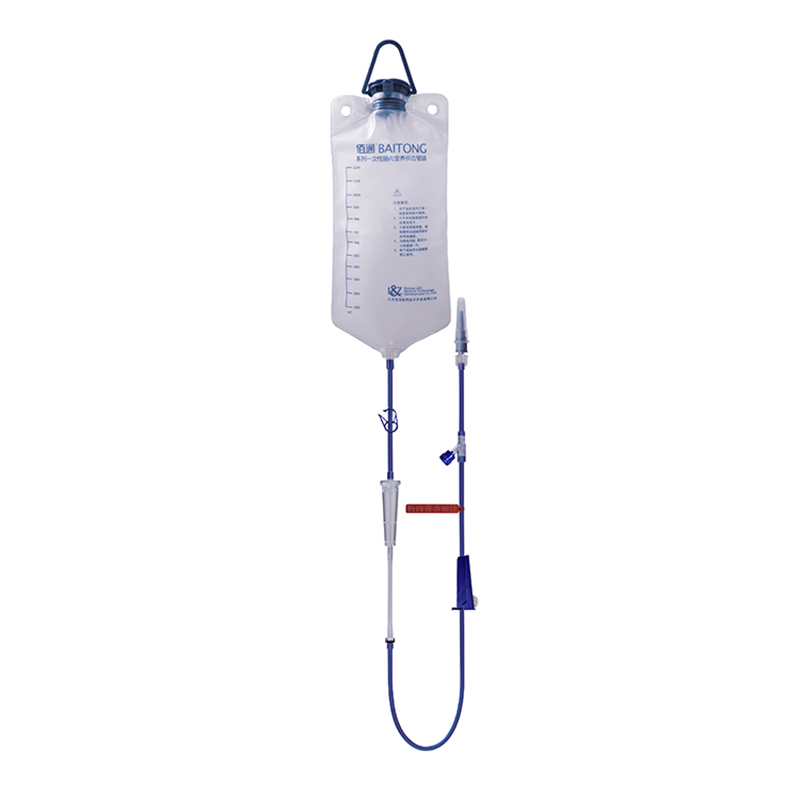
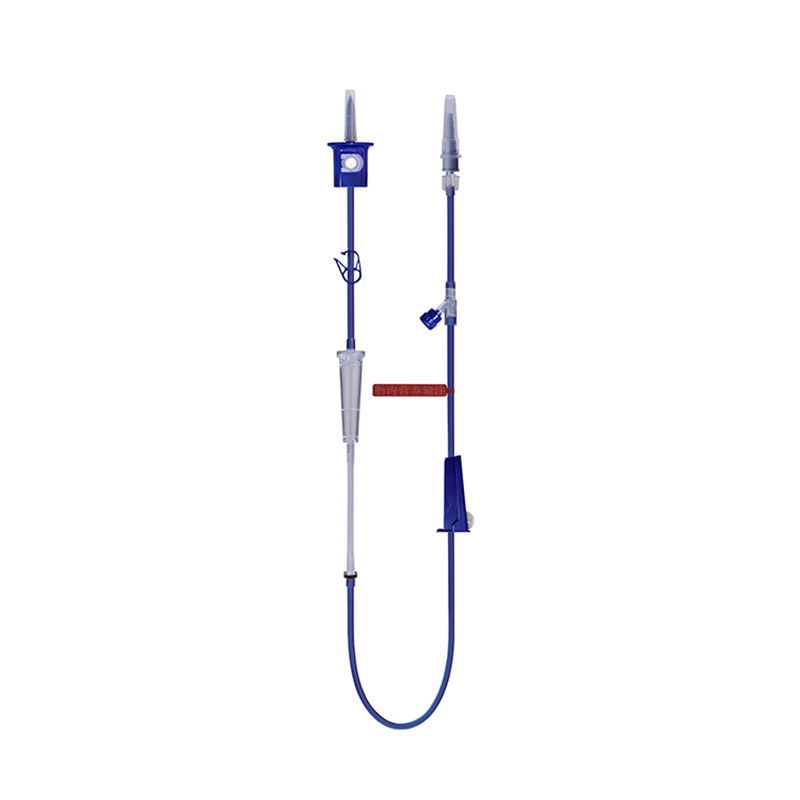
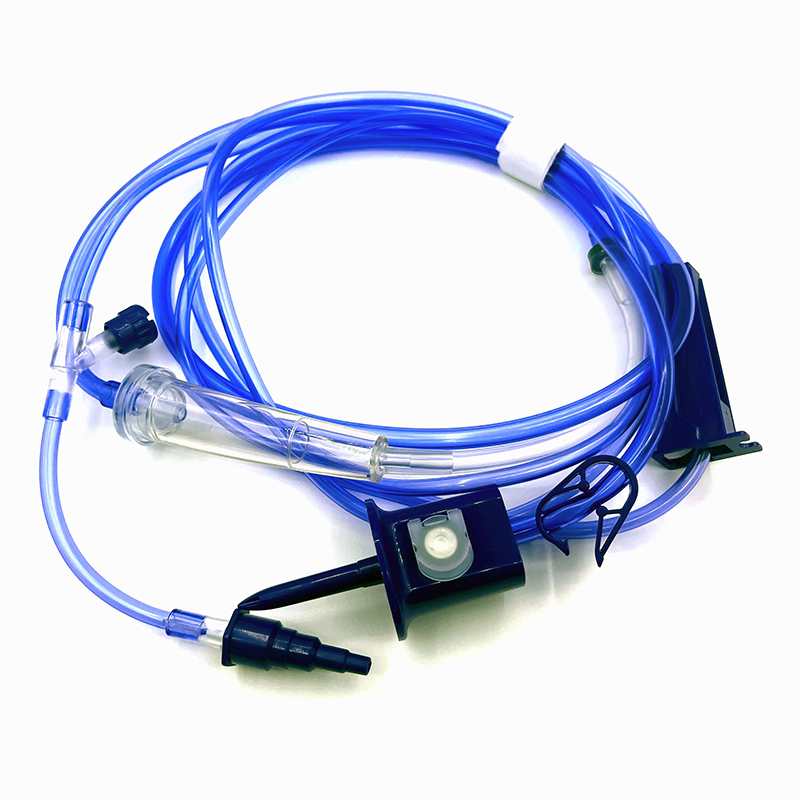


Related Product Guide:
We are convinced that with joint endeavours, the small business between us will bring us mutual benefits. We could assure you products quality and competitive selling price for Wholesale China Enteral Feeding Pump Companies Factory - Enteral feeding sets – LINGZE , The product will supply to all over the world, such as: Belgium, Lisbon, Florida, We strongly believe that technology and service is our base today and quality will create our reliable walls of future. Only we have better and better quality , could we achieve our customers and ourselves, too. Welcome customers all over the word to contact us for getting further business and reliable relationships. We are always here working for your demands whenever you need.
This supplier's raw material quality is stable and reliable, has always been in accordance with the requirements of our company to provide the goods that quality meet our requirements.

